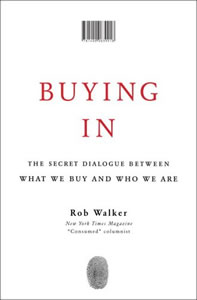 Subtitled “The Secret Dialogue Between What We Buy And Who We Are“, this book attempts to answer the branding question: Why should someone buy my product? People place a value on a product based on how owning it makes them feel/seem. It’s part status and part comfort. This book shows why this isn’t quite correct.
Subtitled “The Secret Dialogue Between What We Buy And Who We Are“, this book attempts to answer the branding question: Why should someone buy my product? People place a value on a product based on how owning it makes them feel/seem. It’s part status and part comfort. This book shows why this isn’t quite correct.
Branding has become a bigger piece of the marketing mix because products themselves are all uniformly good. Early product choices tend to suffer (from poor quality or inefficient production costs) and therefore early choices becomes picking the product that actually works (well). But as goods have evolved, most of the choices for existing product niches are basically equivalent. So companies tried to infuse their products with “meaning” to differentiate themselves. Why own a BMW, a Lexus, a Ferrari, or a Smart Car? They all can get you to where you’re going safely, comfortably, efficiently, and come in a range of colors. So companies have created images of the person who owns their product. Buying the product them is a way to be part of their “brand” community.
(Un)fortunately, people are not sheep. Just because a company projects an image doesn’t mean the community will embrace it. In fact, sometimes the wrong community (think “leading edge trendsetters”) embrace the product for their own purposes. Also, people now get their information from a wealth of choices. Before there were few TV channels and one local newspaper. Now, with hundreds of TV channels and the virtually limitless Internet how can a company use their branding to convince people to buy their product?
The explosion of media choice also has enabled a wealth of small communities to form (critical mass can now be achieved online quickly). These communities may rewrite the branding message to make it appeal to them. There is no longer a single easy demographic to market to – there’s now a more vocal range of smaller communities, all of who may like a product for different reasons.
Murketing is the term that the author has created to describe new way of spreading the message: inserting their branding message in non-obvious ways (instead of a commercial, think product placements or corporate sponsorships of niche events) and giving people a reason to talk about the brand (“word of mouth”). It’s not that people are immune to advertising, it’s just that people don’t want to be sold to – they want to share a common experience. Whether that be outrageous stunts that Red Bull underwrites or enrolling the average person to become a BzzAgent (to become not just a consumer, but a leading edge tester) – it’s trying to get the product message to spread.
The book touches upon many topics and companies from bigger/established companies (Pabst Brewing Company, Apple, Scion, Proctor & Gamble, and Nike) to smaller/newer companies (Etsy, American Apparel, Barking Irons, and The Hundreds). It analyzes why the average consumer really doesn’t care about the “green movement” marketing message (people aren’t looking for ethical products – they are looking for products that appeal to their self-interest).
The book concludes with our internal “secret” dialogue: “Surround yourself only with who you are.” It’s not so much about broadcasting who we are – it’s rather ensuring that we’re in a world that feels comfortable to us.